Polycythemia vera erythroid precursors exhibit increased proliferation and apoptosis resistance associated with abnormal RAS and PI3K pathway activation
- PMID: 19815050
- PMCID: PMC2783925
- DOI: 10.1016/j.exphem.2009.09.009
Polycythemia vera erythroid precursors exhibit increased proliferation and apoptosis resistance associated with abnormal RAS and PI3K pathway activation
Abstract
Objective: Polycythemia vera (PV) is characterized by erythrocytosis associated with the presence of the activating JAK2(V617F) mutation in a variable proportion of hematopoietic cells. JAK2(V617F) is detected in other myeloproliferative neoplasms, does not appear to be the PV-initiating event, and its specific role in deregulated erythropoiesis in PV is incompletely understood. We investigated the pathogenesis of PV to characterize abnormal proliferation and apoptosis responses and aberrant oncogenic pathway activation in primary PV erythroid precursors.
Materials and methods: Peripheral blood CD34(+) cells isolated from PV patients and healthy controls were grown in liquid culture to expand a population of primary erythroblasts for experiments designed to analyze cellular proliferation, apoptosis, JAK2(V617F) mutation status, cytokine-dependent protein phosphorylation and gene expression profiling using Affymetrix microarrays.
Results: The survival and proliferation of PV erythroblasts were growth factor-dependent under strict serum-free conditions requiring both erythropoietin (EPO) and stem cell factor. PV erythroblasts exhibited EPO hypersensitivity and enhanced cellular proliferation associated with increased EPO-mediated extracellular signal-regulated kinases 1 and 2 phosphorylation. EPO-induced AKT phosphorylation was observed in PV but not normal erythroblasts, an effect associated with apoptosis resistance in PV erythroblasts. Analysis of gene expression and oncogenic pathway activation signatures revealed increased RAS (p<0.01) and phosphoinositide-3 kinase (p<0.05) pathway activation in PV erythroblasts.
Conclusion: Deregulated erythropoiesis in PV involves EPO hypersensitivity and apoptosis resistance of erythroid precursor cells associated with abnormally increased activation of RAS-ERK and phosphoinositide-3 kinase-AKT pathways. These data suggest that investigation of the mechanisms of abnormal RAS and phosphoinositide-3 kinase pathway activation in erythroblasts may contribute to our understanding of the molecular pathogenesis of PV.
Figures
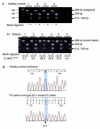
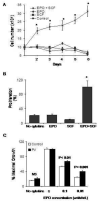
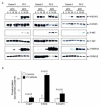

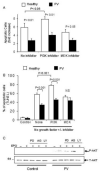
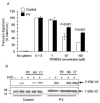
Similar articles
-
Increased death receptor resistance and FLIPshort expression in polycythemia vera erythroid precursor cells.Blood. 2006 May 1;107(9):3495-502. doi: 10.1182/blood-2005-07-3037. Epub 2005 Dec 29. Blood. 2006. PMID: 16384930
-
Increased erythropoiesis in polycythemia vera is associated with increased erythroid progenitor proliferation and increased phosphorylation of Akt/PKB.Exp Hematol. 2005 Feb;33(2):152-8. doi: 10.1016/j.exphem.2004.10.017. Exp Hematol. 2005. PMID: 15676208
-
JAK2 V617F stimulates proliferation of erythropoietin-dependent erythroid progenitors and delays their differentiation by activating Stat1 and other nonerythroid signaling pathways.Exp Hematol. 2016 Nov;44(11):1044-1058.e5. doi: 10.1016/j.exphem.2016.07.010. Epub 2016 Jul 26. Exp Hematol. 2016. PMID: 27473563 Free PMC article.
-
Polycythemia vera: scientific advances and current practice.Semin Hematol. 2005 Oct;42(4):206-20. doi: 10.1053/j.seminhematol.2005.08.003. Semin Hematol. 2005. PMID: 16210034 Review.
-
Current diagnostic criteria for the chronic myeloproliferative disorders (MPD) essential thrombocythemia (ET), polycythemia vera (PV) and chronic idiopathic myelofibrosis (CIMF).Pathol Biol (Paris). 2007 Mar;55(2):92-104. doi: 10.1016/j.patbio.2006.06.002. Epub 2006 Aug 21. Pathol Biol (Paris). 2007. PMID: 16919893 Review.
Cited by
-
The extracellular signal-regulated kinase 1/2 modulates the intracellular localization of DNA methyltransferase 3A to regulate erythrocytic differentiation.Am J Transl Res. 2020 Mar 15;12(3):1016-1030. eCollection 2020. Am J Transl Res. 2020. PMID: 32269731 Free PMC article.
-
The Role of PI3K/AKT and MAPK Signaling Pathways in Erythropoietin Signalization.Int J Mol Sci. 2021 Jul 19;22(14):7682. doi: 10.3390/ijms22147682. Int J Mol Sci. 2021. PMID: 34299300 Free PMC article. Review.
-
Targeting JAK2 in the therapy of myeloproliferative neoplasms.Expert Opin Ther Targets. 2012 Mar;16(3):313-24. doi: 10.1517/14728222.2012.662956. Epub 2012 Feb 17. Expert Opin Ther Targets. 2012. PMID: 22339244 Free PMC article. Review.
-
Distinct clinical phenotypes associated with JAK2V617F reflect differential STAT1 signaling.Cancer Cell. 2010 Nov 16;18(5):524-35. doi: 10.1016/j.ccr.2010.10.013. Cancer Cell. 2010. PMID: 21074499 Free PMC article.
-
Molecular Pathways Involved in the Development of Congenital Erythrocytosis.Genes (Basel). 2021 Jul 28;12(8):1150. doi: 10.3390/genes12081150. Genes (Basel). 2021. PMID: 34440324 Free PMC article. Review.
References
-
- Prchal JF, Axelrad AA. Letter: Bone-marrow responses in polycythemia vera. N Engl J Med. 1974;290:1382. - PubMed
-
- Eaves CJ, Eaves AC. Erythropoietin (Ep) dose-response curves for three classes of erythroid progenitors in normal human marrow and in patients with polycythemia vera. Blood. 1978;52:1196–1210. - PubMed
-
- Casadevall N, Vainchenker W, Lacombe C, et al. Erythroid progenitors in polycythemia vera: demonstration of their hypersensitivity to erythropoietin using serum free cultures. Blood. 1982;59:447–451. - PubMed
-
- Hess G, Rose P, Gamm H, Papadileris S, Huber C, Seliger B. Molecular analysis of the erythropoietin receptor system in patients with polycythaemia vera. Br J Haematol. 1994;88:794–802. - PubMed
Publication types
MeSH terms
Substances
Grants and funding
LinkOut - more resources
Full Text Sources
Other Literature Sources
Research Materials
Miscellaneous

